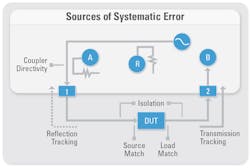This file type includes high resolution graphics and schematics when applicable.
A month ago, I sat with my 1-year-old daughter in the audiologist’s office for a hearing test. The doctor pulled out a DMM-looking instrument with an earhole-shaped probe attached to it. Then, the doctor put the probe into my daughter’s ear, pushed a few buttons on the instrument, and pronounced that there was fluid in her middle ear. I was amazed at this little device, which produces a pulse of sound and then measures the reflection coming back from the middle ear.
While my daughter’s ears ended up being okay (the 40-dB hearing loss was fixed with tubes), her experience reminded me of the notion that measuring incident and reflected signals can be extremely useful. While the audiologist was measuring sound pressure, the instrument (called a tympanometer) wasn’t entirely different than one that I frequently use in the lab—the vector network analyzer (VNA). If I can understand at least at a high level how a tympanometer works, then certainly everyone should be able to understand my instrument, the VNA.
Why We Use VNAs
Engineers designing radio communications systems frequently require detailed knowledge about the exact behavior of the components that go into creating a radio. VNAs are unique stimulus-response instruments that can make extremely accurate RF power and phase measurements by accounting for various sources of systematic error, the largest of which is electromagnetic reflections. While impedance mismatch (and the reflections that follow) isn’t the only source of uncertainty in an RF power measurement (factors such as noise and non-linearity also contribute to uncertainty), they are certainly one of the most significant sources of error. Moreover, a VNA can easily mitigate this source of systematic error.
First, consider the behavior of a microwave filter. As one might expect, a filter is designed to pass signals within one particular range of frequencies while rejecting signals in another range of frequencies. Of course, no component can do this perfectly. Thus, any engineer using the filter will care about metrics such as the passband insertion loss (signal loss in the “passband” region) and the stopband rejection.
At first glance, it might seem reasonable to test the filter with an RF signal generator and a power meter. After all, you can set up a signal generator to produce an RF signal at a calibrated output power and center frequency. Also, a power meter is explicitly designed to measure RF power. However, this measurement setup simply cannot measure insertion loss with the degree of accuracy often required primarily because of the inability of the instrument to account for the largest source of uncertainty in most power measurements—electromagnetic reflections. While one might be lucky to achieve 0.2-dB accuracy using the signal generator and power meter setup, VNAs can be much more accurate.
Transmission Lines And Characteristic Impedance
The basic theory of power transfer through mediums is that with any wave traveling through one medium, any change in medium results in something less than 100% of power transferring to the new medium. Of course, whatever signal doesn’t make it through either comes back as a reflection or is dissipated as heat.
We notice this phenomenon most often when looking through a pane of glass. If a windowpane could pass 100% of the light, we would never see our reflection in the glass. However, because the average single-pane window has a transmisivity of about 80% for the visible spectrum (some special glass does better), the remaining 20% of light contributes to the reflection.
The same principle holds true with electromagnetic waves traveling through a conductive medium such as wire or microstrip. Just as a light reflects when the transmission medium changes, so do electromagnetic signals. What’s worse, the reflected signal combines with the transmitted (or incident) signal, creating a resulting “standing wave.”
The standing wave will have reduced power, and it is often characterized by its voltage standing-wave ratio (VSWR). VSWR is the ratio of the maximum standing-wave amplitude to the minimum standing-wave amplitude. With electromagnetic waves, the impedance match between the two mediums will determine the percentage of power transferred and the magnitude of the reflection.
Without accounting for the magnitude of an electromagnetic reflection (a systematic source of error) in a measurement system, it’s impossible to accurately measure power. Thus, when I connect a power meter to the cable on the end of my signal generator to calibrate the stimulus, I might measure –10 dBm. However, the power is more likely –10 dBm ± 0.2 dB, depending on the impedance match between my signal generator, the cable, and power meter.
Going back to the filter example, an insertion loss measurement would require two power measurements, first of the stimulus signal, and second at the output of the filter. Also, because the impedance match determines power transfer, it’s likely that the source’s impedance match with the power meter is different (either better or worse) than its impedance match with the filter. With unknown impedance matches between the various components in this test setup, it’s easy for the overall measurement uncertainty to range from 0.3 dB to 0.5 dB when simply using a source and a power meter.
What Makes A VNA Special
By now, hopefully I proved to you that impedance mismatches and the resulting electromagnetic reflections that occur in an RF measurement system make it difficult to accurately measure how much of a signal’s power is actually transferred to your device under test. However, by measuring the power of these reflections, one can determine the power transfer to the filter and more accurately measure its insertion loss on the other end. The VNA is a unique instrument that uses sources, receivers, and directional couplers.
The directional couplers are one of the key ingredients of a VNA (see the figure). Here, “receiver A” is connected to a directional coupler that separates the incident single (coming from a source) from the reflection coming back from the device under test (DUT). Using this receiver to measure both the magnitude and phase of this reflected wave, the VNA not only can account for the impedance mismatch with the DUT, enabling more accurate insertion loss measurements, it also can use the phase information in the reflection to measure the characteristic impedance of the DUT. Using this setup, it’s not uncommon to measure insertion loss to within 0.1 dB or better of accuracy.
Directional couplers are a key component of a VNA—separating the incident from the reflected signal. However, even the VNA is subject to all sources of inherent uncertainties, such as directivity and transmission/reflection tracking error, as well as impedance mismatch.
VNAs are by no means simple instruments, and there’s a lot more to know. Even a VNA is subject to systematic errors such as directivity (isolation between the source and receiver A), differences in frequency response of receivers, and imperfect source and load match. However, we can see that the basic theory of operation is relatively straightforward.
By understanding how impedance mismatch produces electromagnetic reflections, one can understand how VNAs are able to compensate the largest sources of systematic measurement error by measuring these reflections. Thus, next time you see a VNA on the bench and wonder why it’s so valued by RF engineers, now you know.
David A. Hall is a senior product marketing manager at National Instruments, where he is responsible for RF and wireless test hardware and software products. His job functions include educating customers on RF test techniques, product management, and developing product demos. His areas of expertise include instrumentation architecture, digital signal processing, and test techniques for cellular and wireless connectivity devices. He holds a BS degree with honors in computer engineering from Penn State University.


